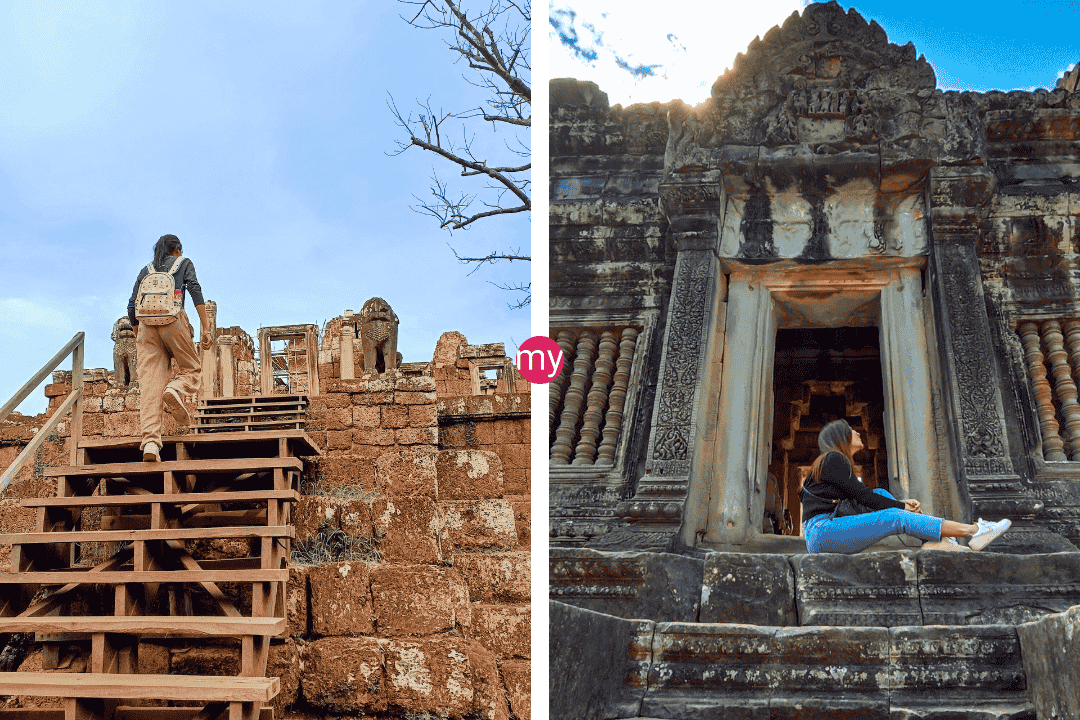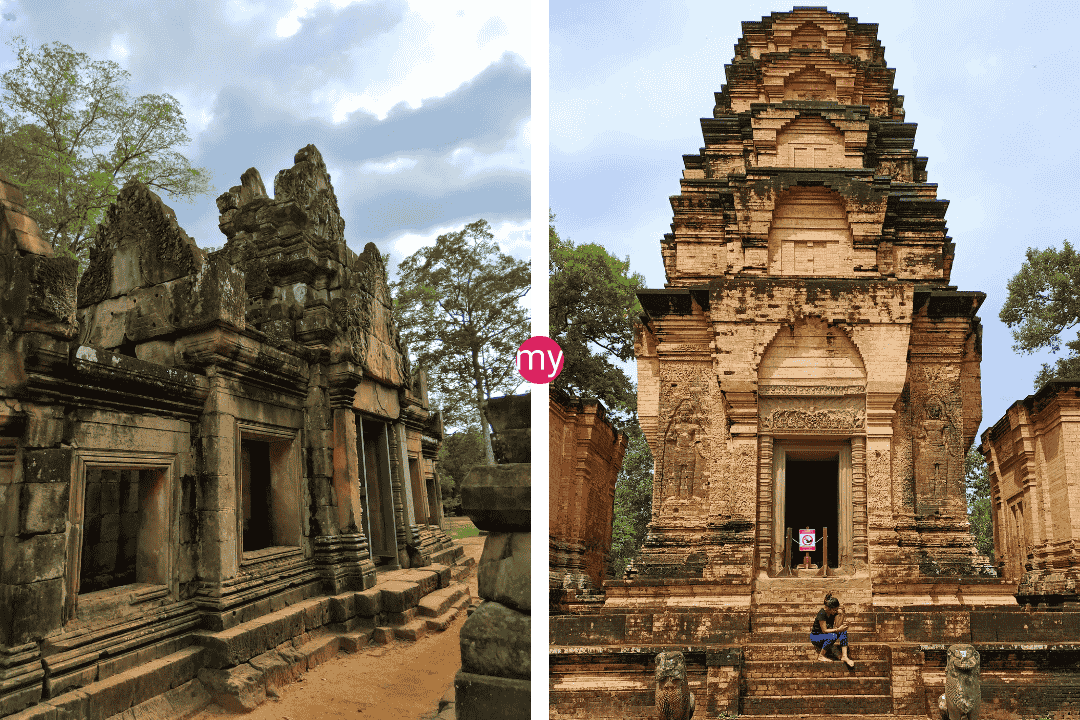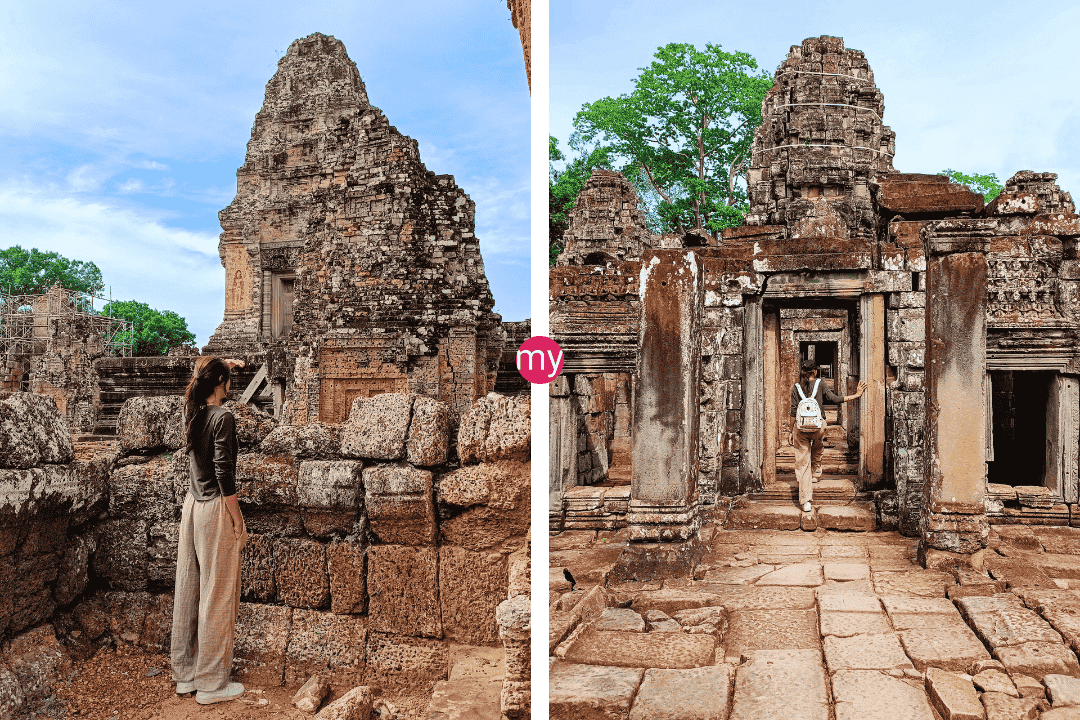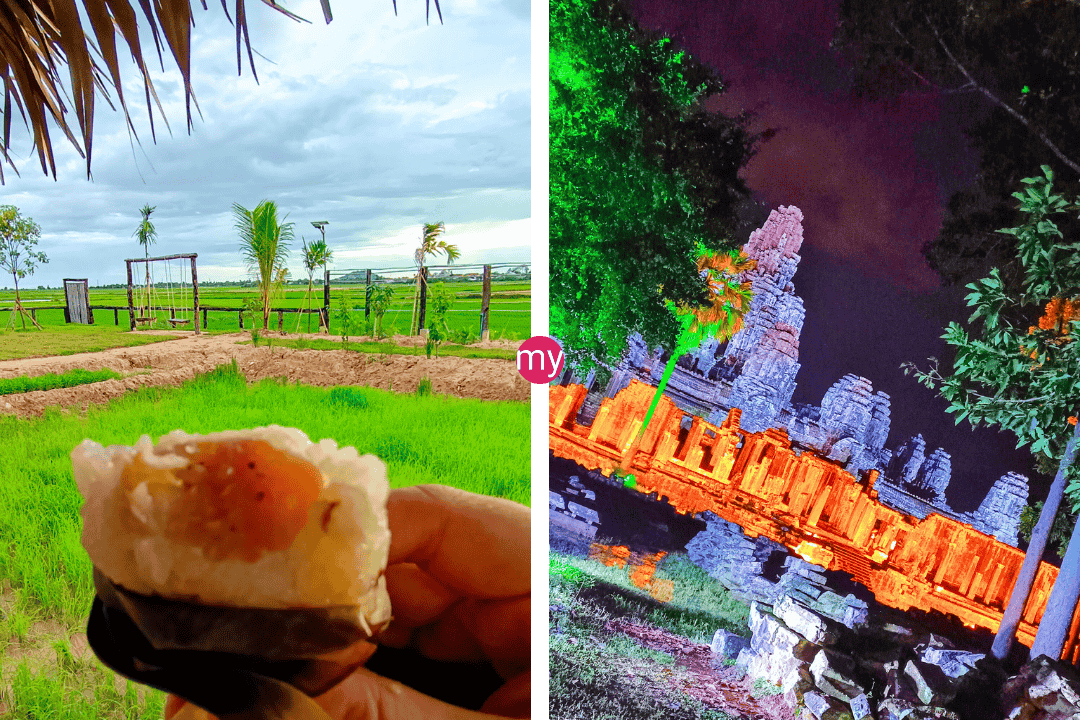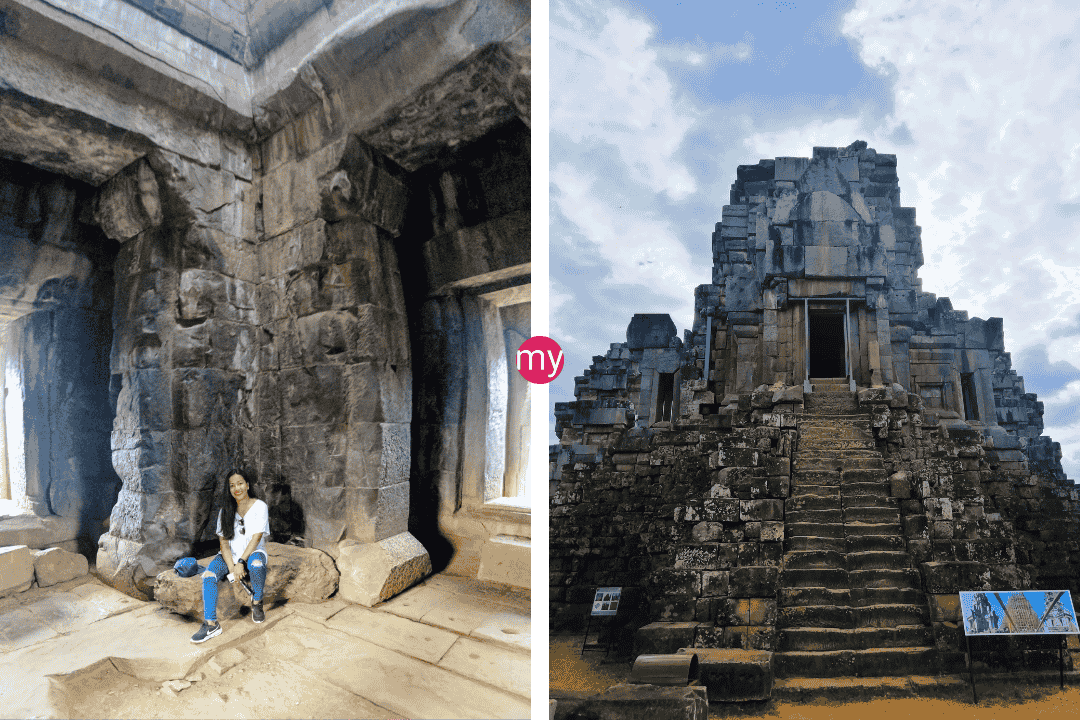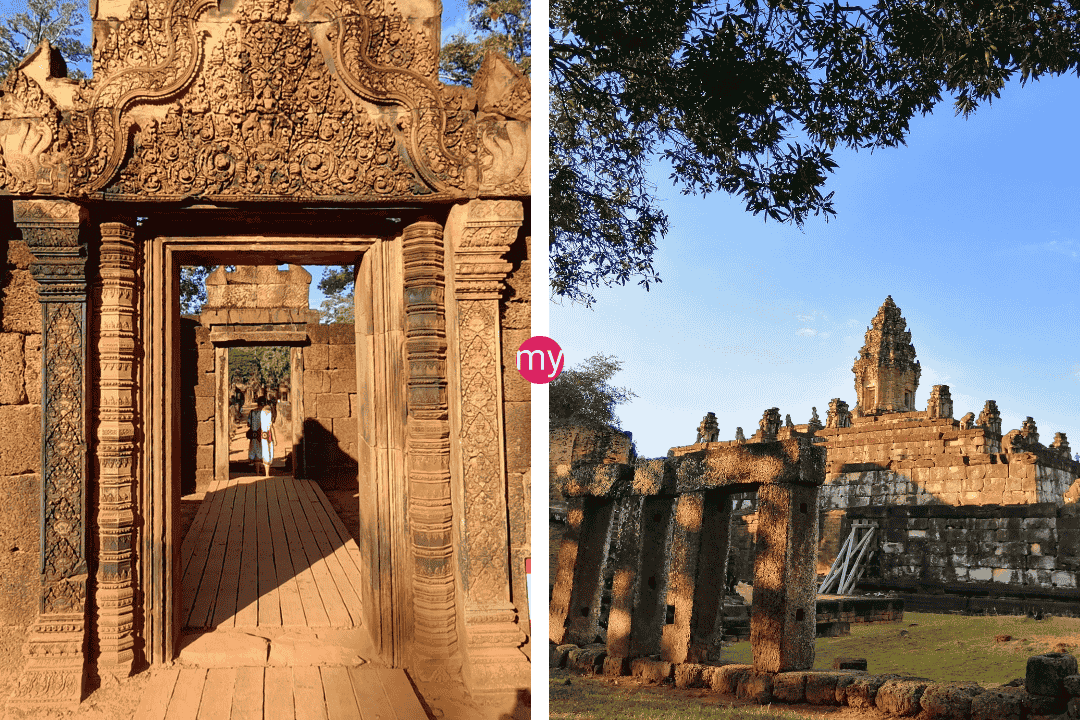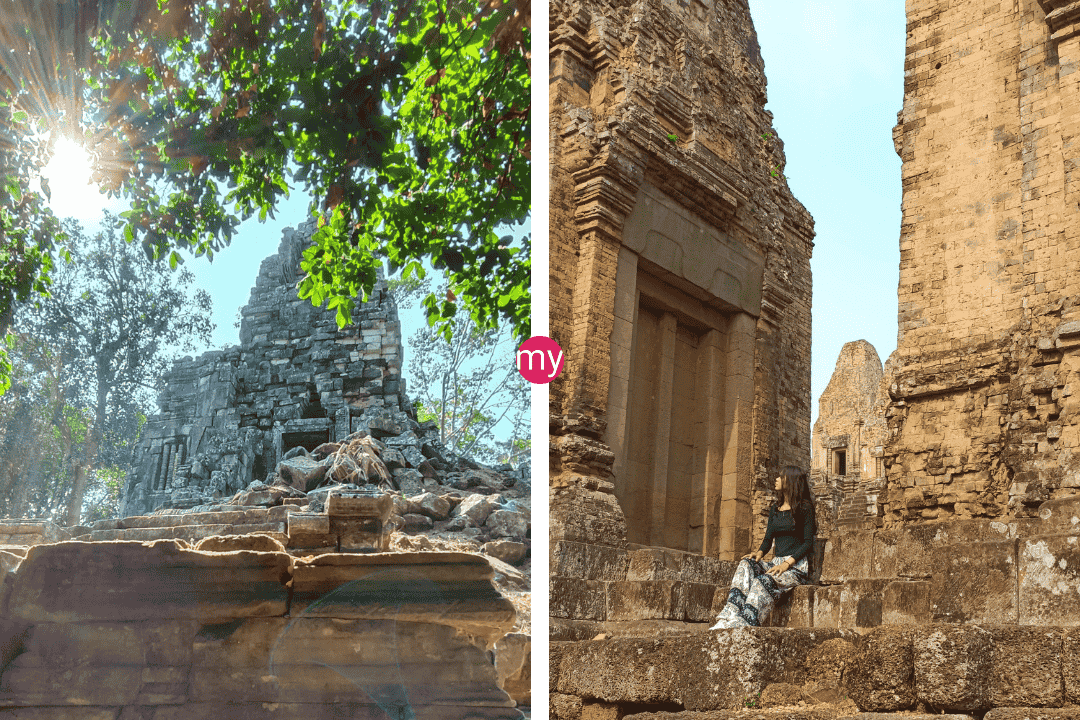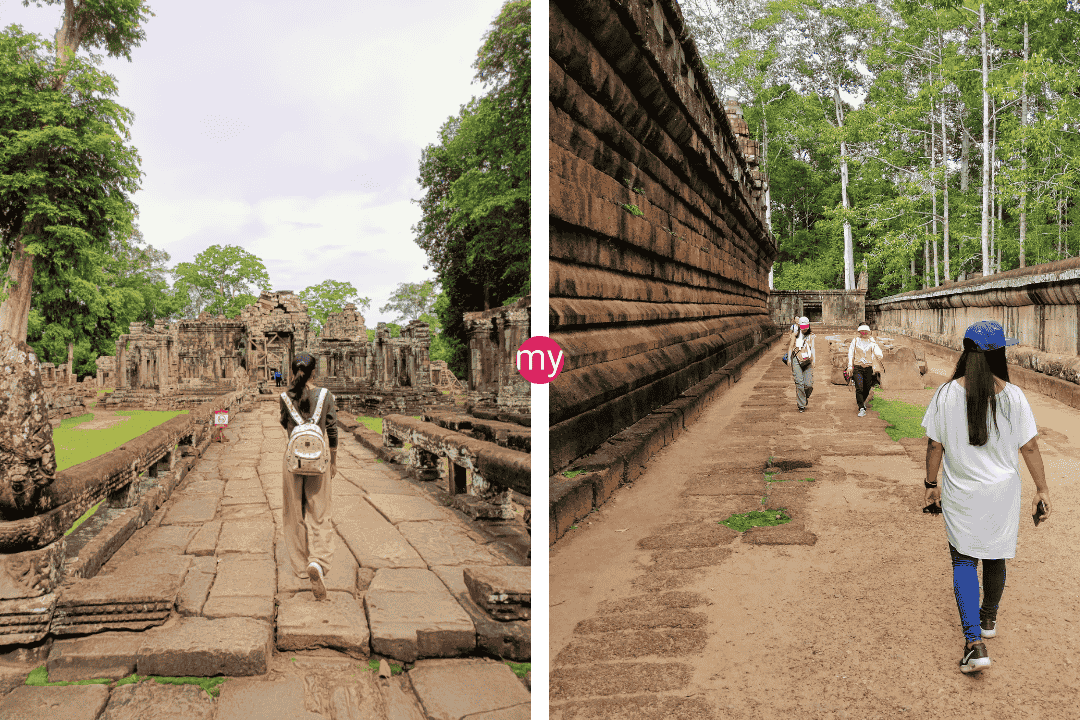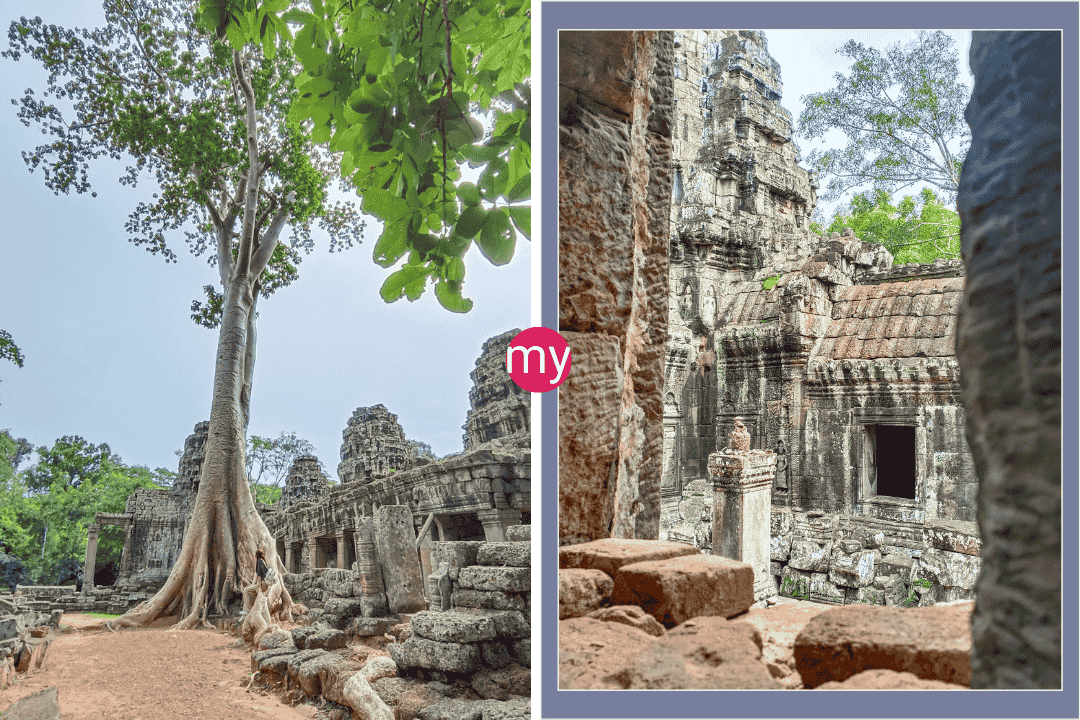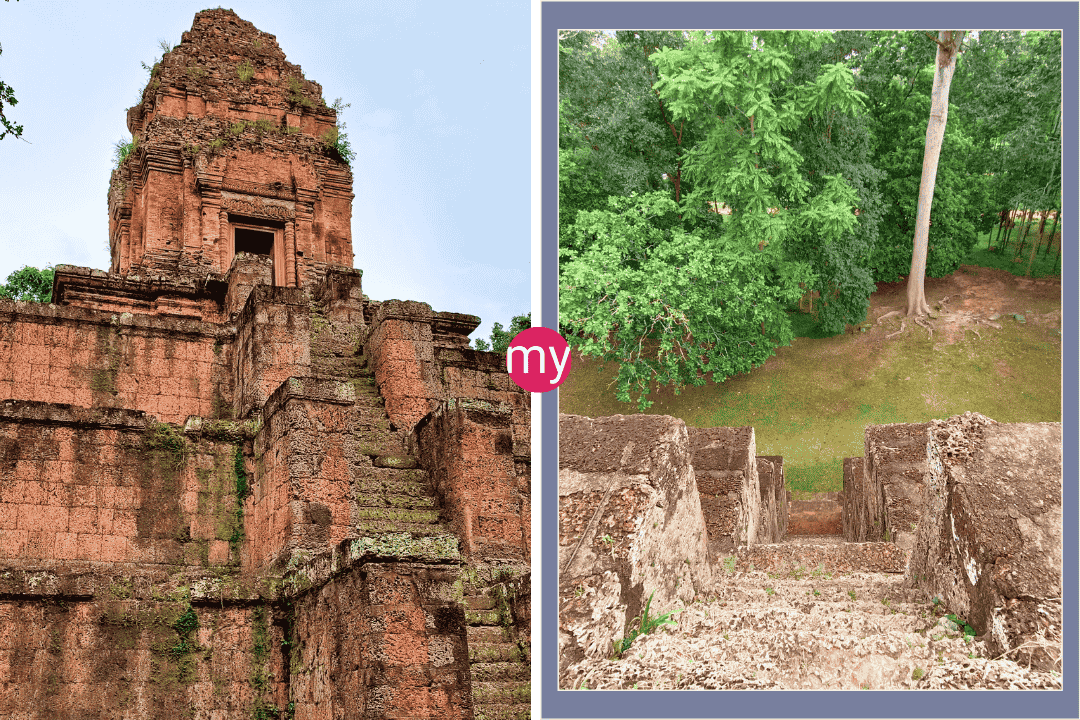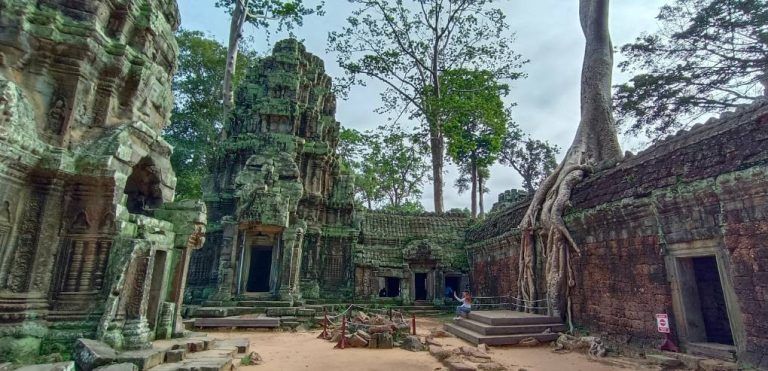
Visit the famous temple of Angkor Wat at sunrise and sunset
As the fading stars yield to the first blush of dawn, the slumbering behemoth awakens. Golden light cascades over mossy megaliths, revealing intricately etched stories of gods and kings on every surface. Our odyssey into the ancient world of Angkor has begun.
Unlock the Mysteries of Angkor Wat: A Private Guided Tour of the Temples at Sunrise and Sunset
Embark on a mythic journey to Cambodia’s ancient megacity, replete with crumbling ruins, mystical stone faces and jungle-choked corridors!
Bask in the glory of Angkor Wat at dawn. Marvel at the intricate carvings bathed in golden light. Lose yourself amidst tangled ruins embraced by nature. Witness the drama of the setting sun igniting ancient towers. A private guided tour of Angkor Wat and beyond offers an experience like no other, unveiling mysteries and magic at every turn. Join us as we uncover the highlights of this awe-inspiring temple complex and lesser-known gems on a customized journey through Cambodian history.
Highlights of Visiting Angkor Wat’s Famous Temples at Sunrise and Sunset:
Arrive before dawn to watch the sun emerge over Angkor Wat
- Stand in anticipation as the first rays illuminate elaborate bas-reliefs and towers
- Explore the grand galleries as sunrise brings the intricate details to life
Discover the wonders of ancient Angkor Thom
- Be awestruck by the mysterious faces of Bayon temple
- Imagine royal gatherings at the Terrace of the Elephants
- Unravel myths carved into the Terrace of the Leper King
Witness nature’s embrace at the jungle temple of Ta Prohm
- Wander spellbound through hallways tangled in giant tree roots
- Feel the presence of the past in the mystical ruins
Venture to lesser-known gems like Banteay Srei and Preah Khan
- Admire the delicate pink sandstone carvings of Banteay Srei
- Get lost in Preah Khan’s maze-like corridors
Capture the drama of sunset at hilltop temples
- Watch the sky ignite in color at Phnom Bok
- Marvel at the silhouetted towers of Pre Rup
Benefits of a Private Guided Tour
- Knowledgeable guides provide insights into history and legends
- Customized itineraries based on your interests and timing
- Exclusive access to secluded spots away from crowds
- Flexibility to explore at your own pace
- Convenience of transports arranged and logistics handled
Planning Your Visit
When to Go
November to February offer ideal weather, smaller crowds.
What to Bring
- Comfortable shoes, lightweight clothing
- Sun protection – hat, sunscreen
- Camera to capture magical moments
- Reusable water bottle
Booking a Tour
Choose guides carefully for expertise, flexibility, and communication skills. Communicate preferences beforehand so they can customize accordingly.
Exploring Angkor Wat at Sunrise
The anticipation is palpable as you arrive in the dark before dawn, joining a hushed crowd before the main temple. The world seems to hold its breath, then erupt in sighs of awe as the first sunbeams illuminate Angkor Wat.
You crane your neck to take in the immense towers, then delve into the galleries with your guide. Each section has stories to tell in intricate bas-reliefs covering every inch of the walls. Gods and demons battle alongside scenes of daily life, all carved over 800 years ago with astounding artistry.
Sunrise brings a kaleidoscope of colors and light cascading through corridors. Your knowledgeable guide narrates tales of Hindu mythology and the temple’s spiritual past as a place of worship. Marveling at the ancient Khmer civilization that built this massive complex, you feel humbled before the sheer scale of human vision and achievement manifested in every precisely carved sandstone block.
Discovering Angkor Thom, the Great City
After soaking in the splendor of Angkor Wat, your private tour takes you to the walled city of Angkor Thom. At its heart rises Bayon, the mesmerizing state temple with over 200 giant carved faces. Their serene smiles and closed eyes exude power and mystery.
As your guide explains, each represents the face of bodhisattva Avalokiteshvara, embodying Buddhist concepts of compassion. Moving through Bayon’s dim passages, the immense features stare down as if tying you to the past. The energy is palpable – statues and bas-reliefs seem alive with religious meaning.
Back outside, you cross terraces that once teemed with royal gatherings and processions. On the Terrace of the Elephants, you envision ceremonial marches of soldiers, musicians and decorated pachyderms during the days of the Khmer empire. The Terrace of the Leper King holds intricate carvings with hidden meanings that your guide deciphers, unveiling the rich symbolism crafted into each structure.
Jungle Temple of Ta Prohm
Where Angkor Wat shows human glory, Ta Prohm reveals nature’s power. As you wander through its crumbling halls strangled by sprawling tree roots, it’s clear why this temple is called the ‘jungle temple’.
Giant trees grow on towers and embed themselves in walls, merging their tendrils seamlessly with the carved blocks. Fig and silk-cotton trees spread their branches wide in courtyards, inhabited by monkeys, birds and other wildlife. Consumed by foliage, the temple emanates a vibe of undiscovered mystery.
Ta Prohm’s fame soared after featuring in the film ‘Tomb Raider’. But even without Hollywood, this is an atmospheric masterpiece. The precarious balance of manmade and natural creates an otherworldly aura. As your guide relays the history, you feel insignificantly small in the face of the relentless passage of time.
Discovering Hidden Gems
Beyond the star attractions, your customized private tour takes you to uncovered gems of Angkor’s lesser-known temples. You marvel at Banteay Srei’s intricate detailed carvings in pink sandstone depicting Hindu myths. Delicate pediments and lintels encrusted in floral motifs demonstrate incredible craftsmanship.
At Preah Khan, you lose yourself in maze-like entryways lined with dancing apsaras and rows of garudas. Wandering alone through these quiet ruins far from the crowds, you feel the spirit and glory of the past palpably surround you.
Your guide takes you off the beaten path to more hidden corners that most tourists never see, revealing the full extent of this ancient mega-city cloaked in jungle.
Sunsets with a View
A fitting finale to an incredible day is watching the sunset from a scenic hilltop temple. Your private tour takes you to Phnom Bok, where you sip refreshments while the sky transforms into a brilliant canvas of color behind Angkor Wat’s distinctive silhouette. Or, you journey to Pre Rup’s pyramidal tiers and soaring towers, perfectly aligned to catch the last light.
At these sunset hill temples, you reflect on the grandeur, ingenuity and artistry witnessed over this journey through history. As the dying rays set temple spires ablaze, you sigh with contentment, mesmerized by the magic.
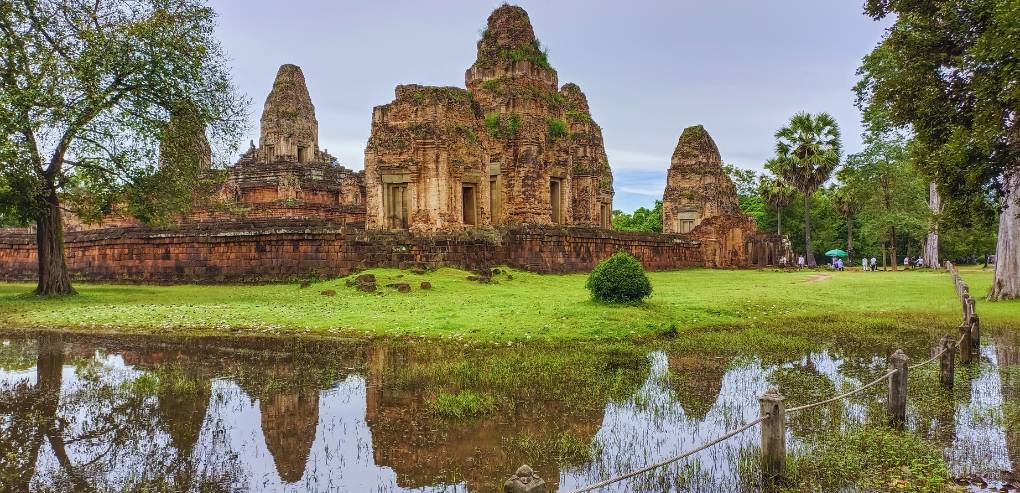
What to look for:
| Chronicle of Mysteries | Temple Highlights | Journeys Through Lost Worlds |
|---|---|---|
| Ancient art and architecture from massive stone temples to intricate bas reliefs | Angkor Wat: Epicenter with iconic lotus towers and detailed mythological carvings | Private Sunrise Tour: Beat the crowds and see the temples illuminated at dawn |
| Hindu and Buddhist iconography and symbology concealed in intricate details | Bayon: Mysterious giant stone smiling faces gazing serenely through corridors | Angkor Small Circuit Tour: Explore mini-complexes like Ta Prohm suffocated by jungle |
| Myths and legends woven into bas reliefs depicting gods, warriors, demons and everyday life | Ta Prohm: Halls and towers swallowed by massive tree roots in an eternal embrace | Angkor Grand Circuit Tour: Discover outlying gems like Banteay Srei’s delicate carvings |
| Lost ancient capitals reclaimed by jungle where nature and architecture merge | Lesser temples: Secluded ruins cloaked in overgrowth await off the beaten track | Kulen Mountain Tour: Remote eroticized riverbed carvings and waterfall swimming |
| Khmer civilization achievements manifested on a monumental and minutely detailed scale | Terraces and libraries: Vestiges of royal ceremonies, gatherings and learning | Beyond Temples Tour: Floating villages, crafts, performances and Cambodian countryside |
Further Reading
Discover our guests most-asked questions from our Telegram chat:
The 9 Most Asked Questions
- What is the best time of day to see Angkor Wat?
- What should I know before watching the sunrise at Angkor Wat?
- What is the sunset like at Angkor Wat? Where are the best places to view it?
- Why take a guided tour of Angkor Wat instead of exploring solo?
- How many days do you need to properly see Angkor Wat?
- What should you wear and bring when visiting Angkor Wat?
- What photography tips and techniques work best for shooting Angkor Wat?
- What are some insider tips for getting the most out of an Angkor Wat tour?
- What are the must-see lesser known temples near Angkor Wat?
1 – What is the best time of day to see Angkor Wat?
Watching the sunrise or sunset at Angkor Wat are experiences like no other, as the monumental towers and stone carvings glow golden in the first light of dawn or ignite ablaze in the drama of dusk. Many travelers struggle to decide when is the best time to visit this ancient temple complex. Should you prioritize sunrise or sunset? Or is midday sightseeing worthwhile too? Here’s an overview of the advantages of visiting Angkor Wat at different times of day:
Sunrise
Arriving early to see the sunrise has a few key perks:
- You’ll beat the crowds and have the temples more to yourself in the early hours before tour buses arrive. The serene, contemplative atmosphere enhances the overall experience.
- Sunlight raking across the towers and galleries creates magnificent lighting effects, bringing bas-reliefs and carvings to life. It’s a photographer’s dream.
- The anticipation builds as you wait for the first sliver of sun to emerge. When it finally appears and illuminates Angkor Wat, it’s a magical moment.
- Temperatures are cooler early in the morning, making exploration more comfortable.
Midday
Visiting Angkor Wat during the late morning to mid afternoon offers some advantages too:
- With the sun high overhead, there are less shadows which helps certain photographic angles.
- No need to rise extremely early, so you can pace yourself conveniently.
- While busier than sunrise, midday crowds thin out as temperatures rise so the major temples don’t feel too packed.
Sunset
Catching the sunset has its own mesmerizing effect:
- The sinking sun casts a dramatic golden light on the towers, creating an unforgettable sight.
- Certain temples like Pre Rup are perfectly aligned for maximum sunset impact.
- As with sunrise, the crowds dissipate so you can experience the magic in peace.
- Lingering until dusk allows you to see Angkor Wat transformed by different lighting.
Conclusion
Ideally, visiting Angkor Wat at both sunrise and sunset allows you to fully experience the spectrum from dawn to dusk. However, if forced to choose one time, sunrise has the edge for its cool weather, ethereal lighting and minimal crowds. But there’s truly no bad time to witness this ancient wonder!
2 – What should I know before watching the sunrise at Angkor Wat?
Securing a sublime sunrise experience at Angkor Wat takes some planning and preparation. Here are some top tips on what to know before you go view those magical first rays over the iconic temple:
Get your entry pass the day before
To avoid ticket lineups in the pre-dawn dark, purchase your Angkor Archaeological Park pass the afternoon or evening prior. Make sure you have the QR code available on your phone.
Arrive early
Be at the Angkor Wat gates by 5:00 am latest to secure a good sunset viewing spot. Claim a seat facing the pond to see the reflection.
Bring a flashlight
Navigating temple corridors before daybreak requires a flashlight or mobile phone light to avoid tripping.
Know where to position yourself
The central tower sees the first rays, then light cascades down to illuminate the rest. Move around to follow the shifting shadows and colors.
Confirm with your guide
If booking a private tour, touch base with your guide the evening before to confirm timing and arrangements.
Check the weather
While rainy season downpours are rare early morning, check the forecast for cloud cover that could obscure sunrise.
Dress for the weather
Temperatures can dip down to 15°C pre-dawn, so wear layers and bring a light jacket.
Pack insect repellent
The abundant pools at Angkor attract mosquitos so apply repellent. Malaria medication may be recommended too.
Bring your camera
A camera capable of long exposure shots is ideal to capture the stunning colors and ethereal light.
Charge batteries
Ensure camera, phone, and flashlight batteries are all fully charged the night prior.
With the right preparation, you’re guaranteed an unforgettable experience watching the Angkor Wat sunrise. Just relax, soak in the splendor, and observe how the temple transforms as dawn’s glow spreads across its ancient face.
3 – What is the sunset like at Angkor Wat? Where are the best places to view it?
In complement to the wondrous sunrise, watching the sunset at Angkor has its own magical allure. As dusk casts its velvety cloak, the last rays set temple spires ablaze before darkness descends. The sheer drama is mesmerizing. But where exactly offers the best vantage points?
The prime spot is atop Phnom Bakheng. The hill provides a panoramic view overlooking the sprawling Angkor Wat complex. Watching its five iconic lotus-shaped towers glow against the setting sun is unforgettable. Arrive early to stake out the ideal lookout point on the crowded summit.
Alternatively, the upper platform of Pre Rup provides a similarly spectacular sunset vista. Its rectangular tiers aligned east-west were purposely designed for viewing dusk’s heavenly display. The brick pyramid structure flames brilliantly orange then fades to silhouette.
For an off-the-beaten-path and more serene sunset, head to Phnom Krom. The hilltop Hindu temple lies secluded south of Siem Reap, surrounded by farms and villages. Grab a peaceful spot in a pavilion and watch the sky transform into a tapestry of color.
Within Angkor Thom, the terraces of the Bayon temple also grant picturesque sunset scenes. The giant stone faces with their enigmatic smiles are particularly evocative bathed in the warm evening glow.
Wherever you choose to station yourself for sundown, the sky igniting in intense hues of vermillion, tangerine and violet is guaranteed to leave you awestruck. Savour the ephemeral magic as day transitions to night over Angkor’s historic monuments.
4 – Why take a guided tour of Angkor Wat instead of exploring solo?
Angkor Wat’s massive complex can seem daunting to experience independently. With over 1,000 temples spread across 160 square miles, having an expert guide makes navigating the archaeological park much easier and more enriching. Here’s why a guided tour is recommended:
Gain Insider Knowledge
A knowledgeable local guide will share fascinating details about Angkor’s history, culture and architecture that you’d never discover alone. Their insights bring the monuments to life.
Avoid Getting Lost
It’s easy to lose your bearings wandering the crumbling ruins. Guides know the labyrinthine layouts to steer you smoothly between sites.
Get Access to Restricted Areas
Guides can bring you into exclusive spots off-limits to regular visitors, like secluded terraces and upper levels.
Skip the Lines
A guide can whisk you past queues straight into temples, maximizing your time and minimizing hassle.
No Transportation Worries
All transit logistics are handled by your guide, whether chauffeured car, tuk tuk, or private boat.
Personalized Experience
Guides tailor tours to your specific interests, whether history, photography, architecture or adventure.
Convenience and Comfort
Let your guide deal with ticketing, provisions, weather issues etc so you can just soak up the magnificence.
Cultural Immersion
Local guides go beyond sightseeing to share personal perspectives on Cambodian culture and traditions.
Exploring Angkor Wat with an experienced guide unlocks secrets you’d never uncover yourself. Let their expertise guide you into ancient mysteries!
5 – How many days do you need to properly see Angkor Wat?
Given the sheer size and scope of Angkor Archaeological Park, many first-timers underestimate how much time they need to fully experience it. While tours of 1-3 days are available, more extended stays are recommended to properly see Angkor Wat and its surrounding treasures. Here’s a breakdown:
1 Day
A single day allows you to see the absolute highlights:
- Sunrise at Angkor Wat
- Angkor Thom and Bayon
- Ta Prohm
- Brief visits to a couple lesser temples
2 Days
Adding a second day lets you dig deeper:
- More extensive temples like the entire Angkor Wat complex
- Multiple sunrise and sunset viewpoints
- Some farther flung sites like Banteay Srei
- A fuller spectrum of different styles of ruins
3 Days
Three days provides ample time to immerse yourself:
- Leisurely exploration of all main temples
- Inclusion of more remote complexes
- Repeat visits to your favorite sites
- Less rushed mornings without crack-of-dawn starts
4+ Days
With four days or longer, you can see it all:
- Hidden corners few tourists reach -Beng Mealea and Kbal Spean
- Floating villages of Tonle Sap Lake
- Museums, villages and cultural sites
- Unhurried pace with time to re-explore favorites
Ultimately, the more days you can spare, the deeper you’ll be able to delve into Angkor’s ancient mysteries. Allow yourself enough time to wander freely without schedule pressure. The rich rewards of lingering in these ancient ruins are ample.
6 – What should you wear and bring when visiting Angkor Wat?
Making sure you wear and bring the right gear can make or break your Angkor Wat experience. Follow these tips on what to pack for comfort and convenience exploring the temples:
Clothing
- Light, breathable fabrics – linen, moisture-wicking synthetics
- Lightweight long pants to protect legs from vegetation
- Closed toe shoes you can walk all day in – sneakers or hiking shoes
- Socks to prevent blisters
- Hat and sunglasses for sun protection
Accessories
- Small backpack or crossbody bag for carrying essentials
- Headlamp or flashlight to illuminate dark temple interiors
- Refillable water bottle to stay hydrated in the heat
- Portable phone charger/external battery pack
- High SPF sunscreen and insect repellent
- Light scarf or sarong for covering bare shoulders respectfully
Technology
- DSLR, mirrorless or point-and-shoot camera
- Mobile phone for photographs too
- Extra batteries and memory cards
- Universal outlet adapter for charging on the go
Other Essentials
- Cash for temple entry fees, donations, vendors
- Photocopies of passport and entry pass in case lost
- Phrasebook or offline translation app if you don’t speak Khmer
With breathable clothing, unencumbering gear, sun protection and camera equipment, you’re fully prepared to explore Angkor Wat in comfort on even the hottest or wettest of days. Don’t let weather disrupt your adventure!
7 – What photography tips and techniques work best for shooting Angkor Wat?
Beyond its ancient history and architecture, Angkor Wat is a photographer’s paradise. Capturing its splendid towers, crumbling ruins and jungle-strangled landscape requires some preparation and photographic know-how:
Equipment
- DSLR or mirrorless camera allows best control over settings
- Wide angle lenses like 14-24mm capture sprawling templescapes
- Telephoto zoom like 70-200mm isolates architectural details
- Tripod for steady low light and long-exposure shots
- Remote shutter release and extra batteries
Shooting Modes
- Manual mode to adjust aperture, shutter speed and ISO
- Aperture priority for depth of field control
- Bracket exposures for high contrast scenes
Exposure
- Lower ISO for clean shots – ISO 100-400 range
- Smaller apertures (higher f-stops) provide greater depth of field
- Adjust shutter speed to handle low light at sunrise/sunset
- Bracket shots and use exposure compensation
Composition
- Lead lines like walkways and colonnades to draw viewers in
- Frame within pillars, doorways and foreground foliage
- Head on and dramatic angles to accentuate height and scale
- Juxtapose intimate portraits with grand architectural views
Lighting
- Golden hours at sunrise and sunset for dramatic warmth
- Diffused sunlight or open shade to avoid harsh shadows
- Reflections in pools and puddles
With the right gear, know-how and artistic eye, you can capture incredible photos at Angkor Wat. Experiment with vantage points and framing to convey majesty and mystery.
8 – What are some insider tips for getting the most out of an Angkor Wat tour?
Beyond just showing up, there are ways to maximize your Angkor Wat experience with these insider tips:
Purchase multi-day pass
The one day pass only allows access to the main Angkor Wat temple, while the 3 and 7 day passes let you enter the entire park.
Get on site by 5am
Beat the tour bus hordes to watch the moving sunrise with just a smattering of fellow early birds.
Move in a clockwise direction
Starting at Angkor Wat and moving clockwise ensures seeing sunrise and sunset from all the best vantage points.
Take the remork car exit
Leaving Angkor Wat via the remork (tuk tuk) exit at the end avoids having to walk all the way back.
Capture nature merging with ruins
Photograph where jungle foliage and trees seamlessly blend into the ancient structures.
Dine at temples
There are restaurants within temple grounds offering atmospheric meals amidst ruins.
Climb up everything
Ascend every open stairway and ladder for views from unique high vantage points.
Explore the outer reaches
Venture beyond just Angkor Wat to outer temples for a more authentic experience.
With insider tips from a knowledgeable guide, you’re guaranteed to have an unforgettable experience at Angkor Wat. Take the paths less traveled for memories to last a lifetime.
9 – What are the must-see lesser known temples near Angkor Wat?
Though Angkor Wat hogs the spotlight, dozens of lesser-known temples scatter the surrounding jungles and rice fields. Venturing to these hidden gems will unveil ruins and landscapes devoid of tourist hordes. Here are some to put on your Angkor itinerary:
Ta Som – Shrouded in tangled vines, this petite temple exudes romantic atmosphere through weathered streets and encroaching greenery.
Banteay Samre – With its moat and central temple, this “citadel of the Samre” offers a microcosm of Angkorian architecture.
Phnom Krom – Hilltop Hindu temple with sweeping views of Tonle Sap Lake and the paddy fields below.
Beng Mealea – Built in the same style as Ta Prohm, Beng Mealea’s collapsed towers and galleries smothered in vegetation create an intentional ruin.
Kbal Spean – Head high into the Kulen Hills to see the sacred “River of 1000 Lingas,” carved riverbed sculptures.
Banteay Srei – The ornate carvings at this petite pink temple earned it the nickname “Citadel of the Women.”
Roluos Group – Representing the earliest Angkorian-era capitals, these sites provide insight into founding of the empire.
Floating Villages – Whether Kampong Phluk, Kompong Khleang or Mechrey, these lake towns offer a look at everyday rural life.
By escaping the crowds and heading off-grid, you’ll unlock a more authentic side of ancient Angkor. Wandering these mossy temples engulfed in lush jungle or floating along sleepy waterways is an experience you won’t soon forget! Let’s escape those tourist traps.
Conclusion: A Window to the Past
As your private guide brings Khmer history to life, you gain a profound appreciation for the accomplishments of this great civilization. Through their monumental temples, you glimpse the cosmology, mythologies and everyday realities that shaped their world.
Beyond just passive sightseeing, you connect viscerally with the past. Exploring these temples at the dramatic moments of sunrise and sunset adds a precious dimension, as if you’re witnessing the passages of time that created this wonder.
A custom private guided tour allows you to focus on your interests while revealing hidden facets beyond the highlights. Returning home, you treasure a new understanding of the human spirit manifested in Angkor’s temples. Their magnificence etched in memory, you eagerly anticipate the next opportunity to unlock more mysteries on a return pilgrimage to this ancient kingdom.
To embark on your own journey back through the centuries spent wandering among crumbling jungle ruins, contact our expert team at Siem Reap Private Tours to craft your customized Angkor Wat experience. With our passion for sharing Cambodia’s magical heritage, we’ll guide you to iconic temples ablaze in sunrise radiance and lost in the serene shadows of dusk. Let us help you uncover Angkor’s awe-inspiring past.
Featured
Recent Articles
Explore more on My Siem Reap Tours
Koh Ker and Beng Mealea guided tour | Banteay Srei temple tour semi-private guided tour | Angkor Wat Sunrise shared tour | Koh Ker and Beng Mealea guided tour | Morning Siem Reap floating village tour | Afternoon Siem Reap floating village tour | Private Angkor Wat special tour | Kulen Waterfall small group guided Tour | Private Angkor Wat mix temples photo tour
